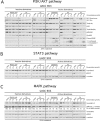Identifying the structure-activity relationship of leelamine necessary for inhibiting intracellular cholesterol transport
- PMID: 28423677
- PMCID: PMC5438648
- DOI: 10.18632/oncotarget.16002
Identifying the structure-activity relationship of leelamine necessary for inhibiting intracellular cholesterol transport
Abstract
Leelamine is an anticancer chemotherapeutic agent inhibiting intracellular cholesterol transport. Cell death mediated by leelamine occurs due to the lysosomotropic property of the compound, its accumulation in the lysosome, and inhibition of cholesterol transport leading to lack of availability for key processes required for functioning of cancer cells. The present study dissects the structure-activity-relationship of leelamine using synthesized derivatives of leelamine and abietic acid, a structurally similar compound, to identify the moiety responsible for anti-cancer activity. Similar to leelamine, all active derivatives had an amino group or a similar moiety that confers a lysosomotropic property to the compound enabling its accumulation in the lysosome. Active derivatives inhibited intracellular cholesterol transport and hindered xenografted melanoma tumor development without obvious systemic toxicity. In silico studies suggested that active derivatives accumulating in lysosomes bound to NPC1, a protein responsible for cholesterol export from the lysosome, to inhibit its activity that then caused accumulation, and lack of cholesterol availability for other key cellular activities. Thus, active derivatives of leelamine or abietic acid maintained lysosomotropic properties, bound to NPC1, and disrupted cellular cholesterol transport as well as availability to retard tumor development.
Keywords: AKT; abietic acid; leelamine; melanoma; structure-activity relationship.
Conflict of interest statement
None.
Figures






References
-
- Kim KB, Kefford R, Pavlick AC, Infante JR, Ribas A, Sosman JA, Fecher LA, Millward M, McArthur GA, Hwu P, Gonzalez R, Ott PA, Long GV, et al. Phase II study of the MEK1/MEK2 inhibitor Trametinib in patients with metastatic BRAF-mutant cutaneous melanoma previously treated with or without a BRAF inhibitor. J Clin Oncol. 2013;31:482–9. - PMC - PubMed
-
- Chan MM, Haydu LE, Menzies AM, Azer MW, Klein O, Lyle M, Clements A, Guminski A, Kefford RF, Long GV. The nature and management of metastatic melanoma after progression on BRAF inhibitors: Effects of extended BRAF inhibition. Cancer. 2014(120):3142–53. - PubMed
-
- Montero J, Morales A, Llacuna L, Lluis JM, Terrones O, Basanez G, Antonsson B, Prieto J, Garcia-Ruiz C, Colell A, Fernandez-Checa JC. Mitochondrial cholesterol contributes to chemotherapy resistance in hepatocellular carcinoma. Cancer Res. 2008;68:5246–56. - PubMed
MeSH terms
Substances
Grants and funding
LinkOut - more resources
Full Text Sources
Other Literature Sources
Medical

